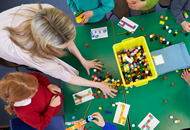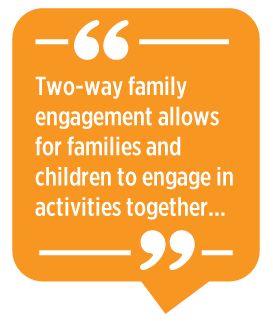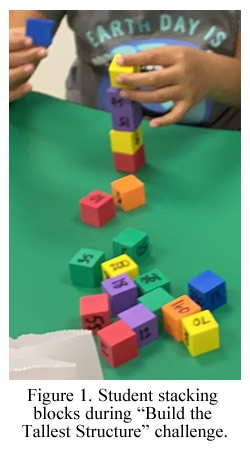Family Engagement Integrating Language and Science
by May H. Lee, Jennifer L. Cody, and Megan E. Lynch

Families of language learners deserve access to
high-quality family engagement, which should be relational, build capacity of
family and staff, and be linked to student learning (Henderson et al., 2007).
Equitable family engagement leads to better outcomes for children (Barajas-López
& Ishimaru, 2016), such as better attendance, higher achievement,
improved attitudes toward learning, and higher graduation rates (García
& Kleifgen, 2018).
The necessity of removing the home and school
barrier has been documented extensively (Ishimaru & Bang, 2016). Family
engagement models, such as the ecologies of parental engagement framework
(Calabrese Barton et. al., 2004), engage families in having “an impact on what
actually transpires around their children in schools and on the kinds of human,
social, and material resources that are valued within schools” (p. 11).
Bidirectional communication, positioning parents/families as knowledge-holders,
and cultural understanding of the multiple ways families support their children
are particularly important for teachers of English learners (National Academies
of Sciences, Engineering, and Medicine, 2018).
Shifts in Terminology
Parent vs.
Family
Family members, including grandparents, aunts,
uncles, siblings, and niblings (i.e., a gender-inclusive term in place of
nieces and nephews) play a large role in supporting and caring for students.
Shifting to more inclusive language opens the door for any and all adults
invested in a student’s education and overall well-being to be included in
family engagement events. Being inclusive of all family members broadens
participation in a culturally sustaining way that honors different cultural
views on caring for children.
Involvement vs.
Engagement
Another language shift is moving from involvement to engagement. Family
involvement invites parents to contribute to the projects, goals, and
initiatives set forth by the school (Ferlazzo & Hammond, 2009). An
example of family involvement, like volunteering in the classroom, while
important, is dictated and regulated by the classroom teacher and/or school.
 Family engagement, on the other hand, is
constructed and done in partnership with parents/families. Family engagement
opportunities may include home visits, participatory action research, and other
events that are not “school-sanctioned” but developed and led collaboratively
by families and school partners. Engagement requires strong relationships, a
commitment to partnership, and continued collaboration. Noting the shift from
involvement to engagement requires a different way of interacting with
parents/family members.
Family engagement, on the other hand, is
constructed and done in partnership with parents/families. Family engagement
opportunities may include home visits, participatory action research, and other
events that are not “school-sanctioned” but developed and led collaboratively
by families and school partners. Engagement requires strong relationships, a
commitment to partnership, and continued collaboration. Noting the shift from
involvement to engagement requires a different way of interacting with
parents/family members.
Often, family engagement activities that take place
in schools are unidirectional, where the teacher “gives” information while
families and children “receive” the information. Two-way family engagement
allows for families and children to engage in activities together where the
facilitator/teacher provides a challenge/task in which the children with
support from their families engage. For example, when families engage in
collaboratively creating, “doing” can allow for children and families’ funds of
knowledge and other forms of cultural capital to be shared and validated.
STEM with Me Family Engagement Program
During the 2019–2020 and 2020–2021 academic year,
Science 2020, a job-embedded professional learning project funded by the Office
of English Language Acquisition, brought together faculty and teacher
candidates from Pennsylvania State University with teachers in eastern
Pennsylvania to codevelop a Pennsylvania K–2 standards-based numeracy program
modeled after the school’s long-standing reading program. Our partner school
faced low academic performance in literacy and math (as measured by
standardized assessments). When cocreating the program, it evolved into “STEM
with Me,” an after-school family engagement program intended to foster in
students a love of STEM concepts and increase foundational math skills. The
three-night event took place over 2 months outside of school hours.
Students and their families collaborated on
building structures, creating patterns, and making ice cream. The program
emphasized numeracy skills, like 1:1 correspondence, standard and nonstandard
measurements, and cardinality. Yet engagement in the engineering design process
and reinforcing fluency in numeracy were not the only goals. Challenging
implicit school and community norms of “English-only” and leveraging all the
linguistic resources of students and their families provided an opportunity to
bring families closer together. Additionally, we strived for families to be
able to draw upon and share cultural and community funds of knowledge to
complete each evening’s activities.
At the same time, the K–2 teachers and university
faculty were able to closely observe interactions and get to know families. At
each session, bilingual family liaisons were available to translate as needed.
Though the STEM with Me overview and sample challenges we describe in this
article contain elements of equitable family engagement, we realize that the
program itself was created and designed by school partners. If we had the
opportunity to do the program again, we would start by getting families
involved in the creation of the curriculum and be codevelopers and
cofacilitators of the work.
Engineering Design Challenges
In the following sections, we describe the purpose,
culture and family connections, preparation, materials, and procedure for three
sample activities within the STEM with Me curriculum.
Challenge 1: Build the Tallest
Structure
Purpose/Intended Outcomes:
Students have the opportunity to count and skip-count numbered blocks to build
block towers and measure them with rulers (standard measurement) or string
(nonstandard measurement) with encouragement and fun-making with their families
(see the Figure. Teachers are able to see the ways students are encouraged,
praised, and supported by family members, which can be later incorporated in
the classroom.
STEM Concepts
- rote counting
- 1:1 correspondence
- number recognition
- number patterns
- skip counting
- measurement (standard and nonstandard)
- greater than, less than
Materials
- 2 sets of 20 foam blocks, equally sized
- permanent marker
- yarn or ribbon
- ruler
 Preparation
Preparation
Prepare the cubes by writing a different number on
each face (side) of the blocks. This can be adjusted for different grade
levels. You can repeat the same numbers on all six sides of the block or write
numbers in increasing order on the blocks (Block 1: 1–6, Block 2: 7–12,
etc.).
Procedure (for
kindergarten)
- You have two sets of blocks. Find blocks with
1, 2, 3, 4, and 5 written on them.
- Put the blocks in order left to right from
1–5.
- Say the number out loud together.
- Scatter the blocks out of order.
- Find the 1 block and place it on the
table.
- Find the next number (2) and stack on top of the
number 1.
- Complete this until all blocks (1–5) are stacked
in order.
- Stack the blocks 1–10. For a more challenging
task, try skip counting your blocks by 2s, 5s, or 10s.
- Make it a game! Use the yarn to measure which
structure is taller.
- Try building new towers with more or all of the
blocks.
- Measure with yarn to compare your new towers.
Which structure is taller/shorter? Which has the greater number of blocks and
lesser number of blocks?
- Try to make towers shorter or taller by using
different types of skip counting.
Culture and Family
Connections
- Repeat the activities by counting in as many
languages as you know.
- Compare and measure using the imperial and metric
systems.
- Share metaphors and other figurative language from
your cultural background that make comparisons (e.g., madder than a wet hen) or
measurements (e.g., the whole 9 yards)
Challenge 2: Marshmallow Toothpick
Shapes and Towers
Purpose/Intended Outcomes: The
challenge is to build a bridge that can hold as many pennies as possible using
mini-marshmallows and toothpicks.
STEM Concepts
- symmetry
- compose and decompose numbers
- addition and subtraction
- doubles (+1 & -1)
- make 5, 10, and 20
- currency
- arrays
- 2D and 3D shape cards
Materials
- 20 mini-marshmallows
- 20 toothpicks
Procedure
- Make two separate piles: one with all of the
marshmallows and one with all of the toothpicks.
- Using these materials, make a pile of five items.
For example, place three marshmallows and two toothpicks together.
- Continue until all combinations of materials that
make five are practiced.
- Count out five marshmallows and five toothpicks.
Put the rest to the side.
- Consider building shapes using only five
marshmallows and five toothpicks.
- Continue making as many shapes as possible with
those materials. Use the shape cards provided or use your
imagination!
- Now that you have explored various 2D and 3D
shapes, build a bridge that is strong enough to hold as many pennies as
possible.
- Design and build your bridge.
- Test your bridge design by placing one penny at a
time on the bridge.
- Make predictions and observations about bridge
design.
- Time permitting: Repeat to see if your bridge can
be built stronger.
Culture and Family
Connections
Examine old family photographs and re-create
structures (houses, buildings, bridges, etc.) from families’ histories and from
the community using the toothpicks and marshmallows.
Challenge 3: Ice Cream
Making
Purpose/Intended Outcomes:
Collaboratively make ice cream while creating space to share recipes and
traditions verbally, visually, and in writing.
STEM Concepts
- measurement
- properties of matter
- states of matter
Materials
- 2 quart-size and 2 gallon-size plastic
bags
- plastic spoons
- measuring cups and measuring spoons
- balance or scale
- newspaper or plastic tablecloths
- 6 cups ice
- 1/3 cups rock salt/ice cream salt
- 4 tablespoons sugar
- 2 cups half & half
- 2 teaspoons vanilla extract (optional)
Procedure
- Label quart-size bags #1 and #2, and
gallon-size bags #1 and #2.
- Measure out 1 cup of half & half and pour in
quart-size bag #1. Repeat in quart-size bag #2.
- Measure out 2 tablespoons of sugar and add to quart-size
bag #1. Repeat in quart-size bag #2.
- Optional: Measure and add 1 teaspoon of vanilla to each
quart-size bag.
- Measure and add 3 cups of ice to gallon-size bag #1.
Repeat with gallon-size bag #2.
- Measure and add 1/3 cup of rock salt/ice cream salt
to gallon-size bag #1. Do not add salt to gallon-size bag
#2.
- Place quart-size bag #1 into gallon-size bag
#1.
- Place quart-size bag #2 into gallon-size bag
#2.
- Shake both bags vigorously for 7–10 minutes, or
until ice cream has hardened in bag #1.
- Remove both quart-size bags and compare/contrast.
Discuss how they are the same and/or different and why.
Culture and Family
Connections
- Read family recipe cards or cookbooks together.
Find recipes and cookbooks in languages that are used at home.
- Write and share recipe cards with other family
members. Translate recipes into multiple languages.
Conclusion
Family engagement in this way, over time, can build
and strengthen relationships between family and school partners. Activities
like the examples provided in this article can provide an opportunity for
students and families to share their experiences, and for teachers to interact
with families beyond back-to-school nights and parent-teacher conferences.
In our school, two-way family engagement
highlighted how ways of being and ways of knowing at home and within the
community can be incorporated and valued in school. Often, we see a
school-to-home connection; seldom do we get to consider how home practices can
be incorporated into school. Through these interactions, school partners are
able to not only familiarize such connections but begin to build them into
classroom instruction in more culturally sustaining and equitable ways.
Research discussed in this paper was
supported by a National Professional Development Grant (T365Z160311) from the
U.S. Department of Education’s Office of English Language Acquisition. This
work would not be possible without the additional support of the Hazleton
Integration Project (https://hip1.org);
the Science 20/20 team (www.science2020k-5.com);
and The Hazleton Area School District (www.hasdk12.org)
References
Barajas-López, F., & Ishimaru, A. M.
(2016). “Darles el lugar”: A place for nondominant family knowing in
educational equity. Urban Education, 55(1), 38–65. https://doi.org/10.1177/0042085916652179
Calabrese Barton, A., Drake, C., Perez, J. G., St.
Louis, K., & George, M. (2004). Ecologies of parental engagement in
urban education. Educational Researcher, 33(4), 3–12.
Ferlazzo, L., & Hammond, L. A. (2009). Building parent engagement in schools. Linworth.
García, O., Kleifgen, J. A. (2018). Educating emergent bilinguals: Policies, programs, and practices for
English learners. Teachers College Press.
Henderson, A. T., Mapp, K. L., Johnson, V. R.,
& Davies, D. (2007). Beyond the bake sale: The essential
guide to family-school partnerships. The New Press.
Ishimaru, A. M., & Bang, M. (2016). Toward a transformative research and practice agenda for racial
equity in family engagement. Family Leadership Design Collaborative. http://familydesigncollab.org
National Academies of Sciences, Engineering, and
Medicine. (2018). English learners in STEM subjects: Transforming
classrooms, schools, and lives. The National Academies Press. https://doi.org/10.17226/25182
May H. Lee is an instructor in curriculum and
instruction at Penn State University. She served as the program coordinator for
Science 20/20: Bringing Language Learners into Focus through Community, School,
University Partnerships. May’s research interests include examining ways to
support and challenge bi/multilingual students across the content areas. Her
recent work emphasizes the ways teacher candidates leverage asset orientations
of bi/multilingual children and their families in schools with high populations
of bi/multilingual students.
Jennifer L.
Cody is a 4th-year PhD candidate in
curriculum and instruction at Penn State University and recently wrapped up
work as a professional development associate and research assistant on the
Science 20/20 Grant Project: Bringing Language Learners into Focus through
Community, School, University Partnerships. In addition, she is currently a
full-time fifth-grade teacher and has taught for 15 years. She has her ESL
certification and is a trained school-based equity advocate. Her research
interest is centered on the ways in which one’s communities of practice
influence equitable and inclusive pedagogical practices in science
instruction.
Megan E. Lynch is a
postdoctoral fellow and the Urban Education Program coordinator at the
University of North Florida in the College of Education and Human Services,
where she collaborates with clinical faculty and Professional Development
School partners to engage in practitioner inquiry. Megan’s research draws on
critical theory to better understand and shape the development of socially just
pedagogy and political activism alongside preservice and in-service teachers and
P–16 students within school-university partnerships.